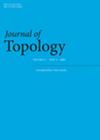求助PDF
{"title":"增广和浸入式拉格朗日填充","authors":"Yu Pan, Dan Rutherford","doi":"10.1112/topo.12280","DOIUrl":null,"url":null,"abstract":"<p>For a Legendrian link <math>\n <semantics>\n <mrow>\n <mi>Λ</mi>\n <mo>⊂</mo>\n <msup>\n <mi>J</mi>\n <mn>1</mn>\n </msup>\n <mi>M</mi>\n </mrow>\n <annotation>$\\Lambda \\subset J^1M$</annotation>\n </semantics></math> with <math>\n <semantics>\n <mrow>\n <mi>M</mi>\n <mo>=</mo>\n <mi>R</mi>\n </mrow>\n <annotation>$M = \\mathbb {R}$</annotation>\n </semantics></math> or <math>\n <semantics>\n <msup>\n <mi>S</mi>\n <mn>1</mn>\n </msup>\n <annotation>$S^1$</annotation>\n </semantics></math>, immersed exact Lagrangian fillings <math>\n <semantics>\n <mrow>\n <mi>L</mi>\n <mo>⊂</mo>\n <mtext>Symp</mtext>\n <mrow>\n <mo>(</mo>\n <msup>\n <mi>J</mi>\n <mn>1</mn>\n </msup>\n <mi>M</mi>\n <mo>)</mo>\n </mrow>\n <mo>≅</mo>\n <msup>\n <mi>T</mi>\n <mo>∗</mo>\n </msup>\n <mrow>\n <mo>(</mo>\n <msub>\n <mi>R</mi>\n <mrow>\n <mo>></mo>\n <mn>0</mn>\n </mrow>\n </msub>\n <mo>×</mo>\n <mi>M</mi>\n <mo>)</mo>\n </mrow>\n </mrow>\n <annotation>$L \\subset \\mbox{Symp}(J^1M) \\cong T^*(\\mathbb {R}_{>0} \\times M)$</annotation>\n </semantics></math> of <math>\n <semantics>\n <mi>Λ</mi>\n <annotation>$\\Lambda$</annotation>\n </semantics></math> can be lifted to conical Legendrian fillings <math>\n <semantics>\n <mrow>\n <mi>Σ</mi>\n <mo>⊂</mo>\n <msup>\n <mi>J</mi>\n <mn>1</mn>\n </msup>\n <mrow>\n <mo>(</mo>\n <msub>\n <mi>R</mi>\n <mrow>\n <mo>></mo>\n <mn>0</mn>\n </mrow>\n </msub>\n <mo>×</mo>\n <mi>M</mi>\n <mo>)</mo>\n </mrow>\n </mrow>\n <annotation>$\\Sigma \\subset J^1(\\mathbb {R}_{>0} \\times M)$</annotation>\n </semantics></math> of <math>\n <semantics>\n <mi>Λ</mi>\n <annotation>$\\Lambda$</annotation>\n </semantics></math>. When <math>\n <semantics>\n <mi>Σ</mi>\n <annotation>$\\Sigma$</annotation>\n </semantics></math> is embedded, using the version of functoriality for Legendrian contact homology (LCH) from Pan and Rutherford [J. Symplectic Geom. <b>19</b> (2021), no. 3, 635–722], for each augmentation <math>\n <semantics>\n <mrow>\n <mi>α</mi>\n <mo>:</mo>\n <mi>A</mi>\n <mo>(</mo>\n <mi>Σ</mi>\n <mo>)</mo>\n <mo>→</mo>\n <mi>Z</mi>\n <mo>/</mo>\n <mn>2</mn>\n </mrow>\n <annotation>$\\alpha : \\mathcal {A}(\\Sigma ) \\rightarrow \\mathbb {Z}/2$</annotation>\n </semantics></math> of the LCH algebra of <math>\n <semantics>\n <mi>Σ</mi>\n <annotation>$\\Sigma$</annotation>\n </semantics></math>, there is an induced augmentation <math>\n <semantics>\n <mrow>\n <msub>\n <mi>ε</mi>\n <mrow>\n <mo>(</mo>\n <mi>Σ</mi>\n <mo>,</mo>\n <mi>α</mi>\n <mo>)</mo>\n </mrow>\n </msub>\n <mo>:</mo>\n <mi>A</mi>\n <mrow>\n <mo>(</mo>\n <mi>Λ</mi>\n <mo>)</mo>\n </mrow>\n <mo>→</mo>\n <mi>Z</mi>\n <mo>/</mo>\n <mn>2</mn>\n </mrow>\n <annotation>$\\epsilon _{(\\Sigma ,\\alpha )}: \\mathcal {A}(\\Lambda ) \\rightarrow \\mathbb {Z}/2$</annotation>\n </semantics></math>. With <math>\n <semantics>\n <mi>Σ</mi>\n <annotation>$\\Sigma$</annotation>\n </semantics></math> fixed, the set of homotopy classes of all such induced augmentations, <math>\n <semantics>\n <mrow>\n <msub>\n <mi>I</mi>\n <mi>Σ</mi>\n </msub>\n <mo>⊂</mo>\n <mi>Aug</mi>\n <mrow>\n <mo>(</mo>\n <mi>Λ</mi>\n <mo>)</mo>\n </mrow>\n <mo>/</mo>\n <mo>∼</mo>\n </mrow>\n <annotation>$I_\\Sigma \\subset \\mathit {Aug}(\\Lambda )/{\\sim }$</annotation>\n </semantics></math>, is a Legendrian isotopy invariant of <math>\n <semantics>\n <mi>Σ</mi>\n <annotation>$\\Sigma$</annotation>\n </semantics></math>. We establish methods to compute <math>\n <semantics>\n <msub>\n <mi>I</mi>\n <mi>Σ</mi>\n </msub>\n <annotation>$I_\\Sigma$</annotation>\n </semantics></math> based on the correspondence between MCFs and augmentations. This includes developing a functoriality for the cellular differential graded algebra from Rutherford and Sullivan [Adv. Math. <b>374</b> (2020), 107348, 71 pp.] with respect to Legendrian cobordisms, and proving its equivalence to the functoriality for LCH. For arbitrary <math>\n <semantics>\n <mrow>\n <mi>n</mi>\n <mo>⩾</mo>\n <mn>1</mn>\n </mrow>\n <annotation>$n \\geqslant 1$</annotation>\n </semantics></math>, we give examples of Legendrian torus knots with <math>\n <semantics>\n <mrow>\n <mn>2</mn>\n <mi>n</mi>\n </mrow>\n <annotation>$2n$</annotation>\n </semantics></math> distinct conical Legendrian fillings distinguished by their induced augmentation sets. We prove that when <math>\n <semantics>\n <mrow>\n <mi>ρ</mi>\n <mo>≠</mo>\n <mn>1</mn>\n </mrow>\n <annotation>$\\rho \\ne 1$</annotation>\n </semantics></math> and <math>\n <semantics>\n <mrow>\n <mi>Λ</mi>\n <mo>⊂</mo>\n <msup>\n <mi>J</mi>\n <mn>1</mn>\n </msup>\n <mi>R</mi>\n </mrow>\n <annotation>$\\Lambda \\subset J^1\\mathbb {R}$</annotation>\n </semantics></math>, <i>every</i> <math>\n <semantics>\n <mi>ρ</mi>\n <annotation>$\\rho$</annotation>\n </semantics></math>-graded augmentation of <math>\n <semantics>\n <mi>Λ</mi>\n <annotation>$\\Lambda$</annotation>\n </semantics></math> can be induced in this manner by an immersed Lagrangian filling. Alternatively, this is viewed as a computation of cobordism classes for an appropriate notion of <math>\n <semantics>\n <mi>ρ</mi>\n <annotation>$\\rho$</annotation>\n </semantics></math>-graded augmented Legendrian cobordism.</p>","PeriodicalId":56114,"journal":{"name":"Journal of Topology","volume":"16 1","pages":"368-429"},"PeriodicalIF":1.1000,"publicationDate":"2023-02-28","publicationTypes":"Journal Article","fieldsOfStudy":null,"isOpenAccess":false,"openAccessPdf":"","citationCount":"7","resultStr":"{\"title\":\"Augmentations and immersed Lagrangian fillings\",\"authors\":\"Yu Pan, Dan Rutherford\",\"doi\":\"10.1112/topo.12280\",\"DOIUrl\":null,\"url\":null,\"abstract\":\"<p>For a Legendrian link <math>\\n <semantics>\\n <mrow>\\n <mi>Λ</mi>\\n <mo>⊂</mo>\\n <msup>\\n <mi>J</mi>\\n <mn>1</mn>\\n </msup>\\n <mi>M</mi>\\n </mrow>\\n <annotation>$\\\\Lambda \\\\subset J^1M$</annotation>\\n </semantics></math> with <math>\\n <semantics>\\n <mrow>\\n <mi>M</mi>\\n <mo>=</mo>\\n <mi>R</mi>\\n </mrow>\\n <annotation>$M = \\\\mathbb {R}$</annotation>\\n </semantics></math> or <math>\\n <semantics>\\n <msup>\\n <mi>S</mi>\\n <mn>1</mn>\\n </msup>\\n <annotation>$S^1$</annotation>\\n </semantics></math>, immersed exact Lagrangian fillings <math>\\n <semantics>\\n <mrow>\\n <mi>L</mi>\\n <mo>⊂</mo>\\n <mtext>Symp</mtext>\\n <mrow>\\n <mo>(</mo>\\n <msup>\\n <mi>J</mi>\\n <mn>1</mn>\\n </msup>\\n <mi>M</mi>\\n <mo>)</mo>\\n </mrow>\\n <mo>≅</mo>\\n <msup>\\n <mi>T</mi>\\n <mo>∗</mo>\\n </msup>\\n <mrow>\\n <mo>(</mo>\\n <msub>\\n <mi>R</mi>\\n <mrow>\\n <mo>></mo>\\n <mn>0</mn>\\n </mrow>\\n </msub>\\n <mo>×</mo>\\n <mi>M</mi>\\n <mo>)</mo>\\n </mrow>\\n </mrow>\\n <annotation>$L \\\\subset \\\\mbox{Symp}(J^1M) \\\\cong T^*(\\\\mathbb {R}_{>0} \\\\times M)$</annotation>\\n </semantics></math> of <math>\\n <semantics>\\n <mi>Λ</mi>\\n <annotation>$\\\\Lambda$</annotation>\\n </semantics></math> can be lifted to conical Legendrian fillings <math>\\n <semantics>\\n <mrow>\\n <mi>Σ</mi>\\n <mo>⊂</mo>\\n <msup>\\n <mi>J</mi>\\n <mn>1</mn>\\n </msup>\\n <mrow>\\n <mo>(</mo>\\n <msub>\\n <mi>R</mi>\\n <mrow>\\n <mo>></mo>\\n <mn>0</mn>\\n </mrow>\\n </msub>\\n <mo>×</mo>\\n <mi>M</mi>\\n <mo>)</mo>\\n </mrow>\\n </mrow>\\n <annotation>$\\\\Sigma \\\\subset J^1(\\\\mathbb {R}_{>0} \\\\times M)$</annotation>\\n </semantics></math> of <math>\\n <semantics>\\n <mi>Λ</mi>\\n <annotation>$\\\\Lambda$</annotation>\\n </semantics></math>. When <math>\\n <semantics>\\n <mi>Σ</mi>\\n <annotation>$\\\\Sigma$</annotation>\\n </semantics></math> is embedded, using the version of functoriality for Legendrian contact homology (LCH) from Pan and Rutherford [J. Symplectic Geom. <b>19</b> (2021), no. 3, 635–722], for each augmentation <math>\\n <semantics>\\n <mrow>\\n <mi>α</mi>\\n <mo>:</mo>\\n <mi>A</mi>\\n <mo>(</mo>\\n <mi>Σ</mi>\\n <mo>)</mo>\\n <mo>→</mo>\\n <mi>Z</mi>\\n <mo>/</mo>\\n <mn>2</mn>\\n </mrow>\\n <annotation>$\\\\alpha : \\\\mathcal {A}(\\\\Sigma ) \\\\rightarrow \\\\mathbb {Z}/2$</annotation>\\n </semantics></math> of the LCH algebra of <math>\\n <semantics>\\n <mi>Σ</mi>\\n <annotation>$\\\\Sigma$</annotation>\\n </semantics></math>, there is an induced augmentation <math>\\n <semantics>\\n <mrow>\\n <msub>\\n <mi>ε</mi>\\n <mrow>\\n <mo>(</mo>\\n <mi>Σ</mi>\\n <mo>,</mo>\\n <mi>α</mi>\\n <mo>)</mo>\\n </mrow>\\n </msub>\\n <mo>:</mo>\\n <mi>A</mi>\\n <mrow>\\n <mo>(</mo>\\n <mi>Λ</mi>\\n <mo>)</mo>\\n </mrow>\\n <mo>→</mo>\\n <mi>Z</mi>\\n <mo>/</mo>\\n <mn>2</mn>\\n </mrow>\\n <annotation>$\\\\epsilon _{(\\\\Sigma ,\\\\alpha )}: \\\\mathcal {A}(\\\\Lambda ) \\\\rightarrow \\\\mathbb {Z}/2$</annotation>\\n </semantics></math>. With <math>\\n <semantics>\\n <mi>Σ</mi>\\n <annotation>$\\\\Sigma$</annotation>\\n </semantics></math> fixed, the set of homotopy classes of all such induced augmentations, <math>\\n <semantics>\\n <mrow>\\n <msub>\\n <mi>I</mi>\\n <mi>Σ</mi>\\n </msub>\\n <mo>⊂</mo>\\n <mi>Aug</mi>\\n <mrow>\\n <mo>(</mo>\\n <mi>Λ</mi>\\n <mo>)</mo>\\n </mrow>\\n <mo>/</mo>\\n <mo>∼</mo>\\n </mrow>\\n <annotation>$I_\\\\Sigma \\\\subset \\\\mathit {Aug}(\\\\Lambda )/{\\\\sim }$</annotation>\\n </semantics></math>, is a Legendrian isotopy invariant of <math>\\n <semantics>\\n <mi>Σ</mi>\\n <annotation>$\\\\Sigma$</annotation>\\n </semantics></math>. We establish methods to compute <math>\\n <semantics>\\n <msub>\\n <mi>I</mi>\\n <mi>Σ</mi>\\n </msub>\\n <annotation>$I_\\\\Sigma$</annotation>\\n </semantics></math> based on the correspondence between MCFs and augmentations. This includes developing a functoriality for the cellular differential graded algebra from Rutherford and Sullivan [Adv. Math. <b>374</b> (2020), 107348, 71 pp.] with respect to Legendrian cobordisms, and proving its equivalence to the functoriality for LCH. For arbitrary <math>\\n <semantics>\\n <mrow>\\n <mi>n</mi>\\n <mo>⩾</mo>\\n <mn>1</mn>\\n </mrow>\\n <annotation>$n \\\\geqslant 1$</annotation>\\n </semantics></math>, we give examples of Legendrian torus knots with <math>\\n <semantics>\\n <mrow>\\n <mn>2</mn>\\n <mi>n</mi>\\n </mrow>\\n <annotation>$2n$</annotation>\\n </semantics></math> distinct conical Legendrian fillings distinguished by their induced augmentation sets. We prove that when <math>\\n <semantics>\\n <mrow>\\n <mi>ρ</mi>\\n <mo>≠</mo>\\n <mn>1</mn>\\n </mrow>\\n <annotation>$\\\\rho \\\\ne 1$</annotation>\\n </semantics></math> and <math>\\n <semantics>\\n <mrow>\\n <mi>Λ</mi>\\n <mo>⊂</mo>\\n <msup>\\n <mi>J</mi>\\n <mn>1</mn>\\n </msup>\\n <mi>R</mi>\\n </mrow>\\n <annotation>$\\\\Lambda \\\\subset J^1\\\\mathbb {R}$</annotation>\\n </semantics></math>, <i>every</i> <math>\\n <semantics>\\n <mi>ρ</mi>\\n <annotation>$\\\\rho$</annotation>\\n </semantics></math>-graded augmentation of <math>\\n <semantics>\\n <mi>Λ</mi>\\n <annotation>$\\\\Lambda$</annotation>\\n </semantics></math> can be induced in this manner by an immersed Lagrangian filling. Alternatively, this is viewed as a computation of cobordism classes for an appropriate notion of <math>\\n <semantics>\\n <mi>ρ</mi>\\n <annotation>$\\\\rho$</annotation>\\n </semantics></math>-graded augmented Legendrian cobordism.</p>\",\"PeriodicalId\":56114,\"journal\":{\"name\":\"Journal of Topology\",\"volume\":\"16 1\",\"pages\":\"368-429\"},\"PeriodicalIF\":1.1000,\"publicationDate\":\"2023-02-28\",\"publicationTypes\":\"Journal Article\",\"fieldsOfStudy\":null,\"isOpenAccess\":false,\"openAccessPdf\":\"\",\"citationCount\":\"7\",\"resultStr\":null,\"platform\":\"Semanticscholar\",\"paperid\":null,\"PeriodicalName\":\"Journal of Topology\",\"FirstCategoryId\":\"100\",\"ListUrlMain\":\"https://onlinelibrary.wiley.com/doi/10.1112/topo.12280\",\"RegionNum\":2,\"RegionCategory\":\"数学\",\"ArticlePicture\":[],\"TitleCN\":null,\"AbstractTextCN\":null,\"PMCID\":null,\"EPubDate\":\"\",\"PubModel\":\"\",\"JCR\":\"Q2\",\"JCRName\":\"MATHEMATICS\",\"Score\":null,\"Total\":0}","platform":"Semanticscholar","paperid":null,"PeriodicalName":"Journal of Topology","FirstCategoryId":"100","ListUrlMain":"https://onlinelibrary.wiley.com/doi/10.1112/topo.12280","RegionNum":2,"RegionCategory":"数学","ArticlePicture":[],"TitleCN":null,"AbstractTextCN":null,"PMCID":null,"EPubDate":"","PubModel":"","JCR":"Q2","JCRName":"MATHEMATICS","Score":null,"Total":0}
引用次数: 7
引用
批量引用

 求助内容:
求助内容: 应助结果提醒方式:
应助结果提醒方式:


